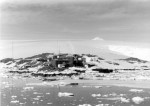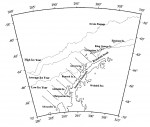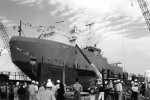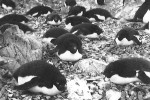The Palmer Station LTER Prepares for a Typical Annual Research Cruise; Christens a New Vessel
David M. Karl, University of Hawaii, Palmer Station LTER
The Palmer Station LTER (PAL) research program is the only marine site in the LTER network. The study area includes a range of habitats from shallow (< 5 m) coastal bays to the deep (> 3000 m) oceanic region that surrounds Antarctica. A grid of 100 stations contained in a 100 x 200 km rectangle aligned parallel to the North-Northeast axis of the Antarctic Peninsula defines the LTER study area (see illustration, below).
An essential field component of the PAL research project is our annual month-long research cruise. During these expeditions, measurements are made of the distributions and abundances of microbial, plant and animal populations and on the physical and chemical conditions of their habitats. These comprehensive, trans-disciplinary at-sea measurements are the heart and soul of the PAL program.
The expedition planning typically begins in April, less than one month after returning from Antarctica at the conclusion of the previous field season. Personnel lists are prepared well in advance of deployment to Antarctica because of the medical and dental exams that are required to ensure our team’s ability to withstand the rigors of high latitude field work. Detailed lists of supplies and chemicals needed to conduct our field programs must also be prepared, reviewed and ordered. There are no hardware stores or chemical supply houses on the frozen continent. In June, the PAL principal investigators meet to plan the detailed sampling and shipboard experimental protocols and to make a final decision on selection of the expedition Chief Scientist. Throughout the summer, plans are finalized. By fall, all participating scientists are physically qualified and we begin to make our final travel plans, including important issues such as the arrangement of dog-sitters, bill-payers and the other essentials of life thatsimply must continue in our absence. Some of the PAL scientists deploy for Antarctica as early as October to begin field work at land-based Palmer Station ahead of the annual cruise. These scientists typically remain in the field for nearly six months at which time they are ready to return home to prepare for the next field season and to get reaquainted with friends and family members. Such is the life of a dedicated PAL scientist.
Our annual LTER research cruise usually departs on or about the first of January from Punta Arenas, Chile, on the Straits of Magellan. Scientists begin to arrive in "PA" a few days before departure to locate and unpack their gear and to set up the shipboard laboratories. Punta Arenas is a small, friendly town literally at the end of the road in the Patagonian region of South America. Before the Panama Canal was constructed, Punta Arenas was a major port and center of commerce for all ships rounding Cape Horn. Today the port continues to support an active fishery and, more recently, an emergent ecotourism industry that includes Antarctic vacation cruises.
One final bit of important business in Punta Arenas is receipt of the Antarctic clothing issue. The Antarctic Support Associates, the civilian contractor for NSF, maintains a warehouse at the port, which facilitates cruise staging. At their polar department store each participant receives a full wardrobe of functional, warm clothing from polypropylene undergarments to a polar hat—all neatly packed into a personal duffel bag. This is a godsend for those of us who live in warm climates (like myself—in Hawaii) and do not normally wear long pants, much less a parka. Now, after nine months of planning and preparation the research vessel that will be our home for the next several weeks is ready to weigh anchor and head south to the Antarctic Peninsula.
Maiden Voyage
The Antarctic Research and Supply Vessel Laurence M. Gould was christened by the ship’s sponsor Mrs. Ruth Siple on 9 October 1997 at the North American Shipbuilders facility in La Rose, Louisiana. The dedication ceremony was attended by NSF and PAL representatives. This newly constructed vessel is named in honor of Laurence McKinley Gould, a world-renowned geologist and educator. Gould was the second-in-command of Richard Byrd’s first Antarctic expedition in 1929 and later served as President of Carleton College. He died in 1996, at the age of 99. The Laurence M. Gould replaces the Norwegian-flagged vessel Polar Duke, which served the U.S. Antarctic research community for the past 13 years.
The new vessel departed from Port Fourchon, Louisiana, on Christmas Day and arrived in Punta Arenas in mid-January to begin her five-year charter service for support of research programs in the region of the Antarctic Peninsula, including the PAL-LTER research activities. Her maiden voyage, the 1998 PAL-LTER annual cruise, was just successfully completed. All those aboard agree that the "Larry" Gould meets or exceeds all expectations.
First Winter Cruise Planned
If that is not enough activity to fill an entire year, 1998 will be remembered by the PAL scientists because of our plans to conduct a second cruise -- this one in the dead of austral winter. Planning for this May-June "ice cruise" is already in the advanced stages. Only a few winter cruises have ever been attempted in this portion of Antarctica and our team considers this to be an excellent opportunity to study the secrets of winter survival in the polar darkness. We also thought that this might be a good way to test the full capabilities of our new vessel, under some of most extreme environmental conditions imaginable. Stay tuned for news of the outcome
Please visit the Palmer Station LTER Web site: http://www.crseo.ucsb.edu/lter/lter.htm

 Enlarge this image
Enlarge this image



